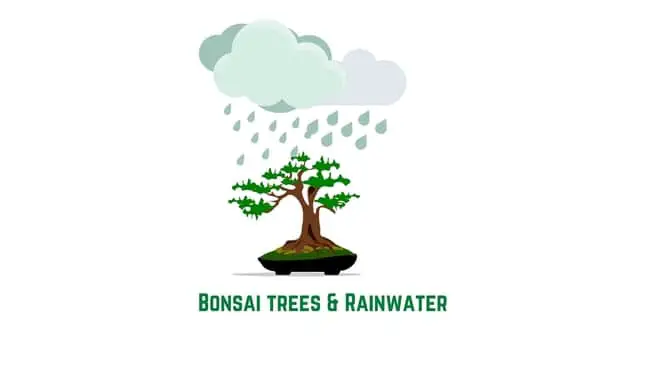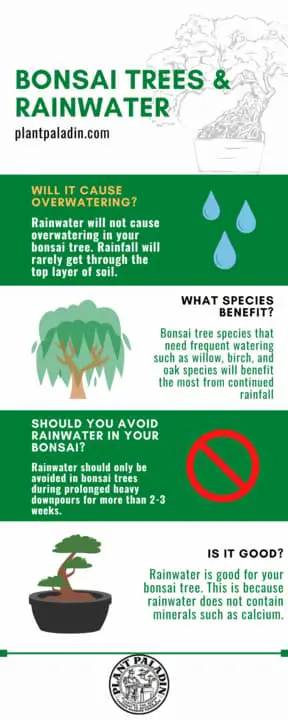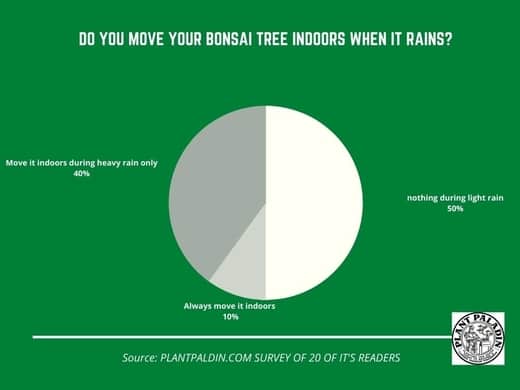This website is supported by its readers. If you click one of my links I may earn a commission. I am also a participant in the Amazon affiliates program and I will also earn a commission from qualified purchases.

Watering is essential to the health of our bonsai trees. Should we let the topsoil of our bonsai trees dry out, they will end up dead. That being said, a lot of us keep our bonsai trees outdoors and unprotected. This got me thinking. What about bonsai trees and rainwater?
Rainwater will not cause overwatering in your bonsai tree. Rainfall will rarely get through the top layer of soil. If heavy rain persists for more than two weeks, move your tree indoors. Rainwater has the benefit of containing no minerals such as calcium, which can harm trees.
So can rainwater overwater your bonsai trees? And what are the downsides to using water in your bonsai? Keep reading to find out more!
Just a quick heads up, over the past three years of running Plantpaladin, hundreds of people have asked for product recommendations. As such, You can find my favorite indoor bonsai tree here (link takes you to Bonsaiboy), my favorite outdoor bonsai tree (link takes you to Bonsaiboy), or have a look at all the products I recommend here.
Bonsai trees and rainwater
For those of us lucky to live with a garden space, more often than not we will keep our bonsai trees outdoors.
This will give us the ability to manage the amount of sunlight which is essential for the health of our trees. Keeping our bonsai outdoors however does come with some problems, mainly insect infestation or high temperatures.
One thing however we have not taken into consideration enough is the effect of rainwater on bonsai trees.
So what exactly is the relationship between bonsai trees and rainwater?
Well, luckily I’ve visited a few garden centers, keep my own bonsai outdoors, and did a quick survey of 20 plant paladin readers.
These were the main findings:
- Leaving your bonsai trees outdoors during the rain will usually be fine.
- This is because most of the rain will not penetrate the top layer of soil or drain through the drainage holes in your bonsai pot.
- Rainwater may have some benefits when compared to using tap water which can contain minerals like calcium.
- If this calcium builds up it can impact the health of your tree.
- Even during heavy rainfall, bonsai trees will be fine to keep outdoors – so long as your bonsai tree is in good health – weakened or damaged trees may struggle.
- Should heavy rainfall persist however for more than a week or so your bonsai may become overwatered – causing root rot and potential fungal infections.
- Bonsai trees then should be moved into a shelter if heavy rainfall persists for more than two weeks.
- To prevent any chances of overwatering – an inorganic bonsai soil mix should be used which will help moisture not build up in your tree.
Let’s explore some of these points in more detail.

Can rainwater overwater your bonsai?
Easily the biggest question and problem people have when it comes to rainwater and bonsai trees is the potential for rainwater to overwater bonsai trees.
After all, bonsai trees are incredibly temperamental, needing more care than other trees. It’s only natural to think that excess rain can cause overwatering.
This isn’t the case.
The truth is the most rainwater rarely gets through the topsoil of bonsai trees.
This means its impact on the roots of your bonsai i.e causing root rot or water to pool is very unlikely to happen.
More often than not, short periods of overwatering your bonsai won’t cause any adverse effect but the consistent overwatering week in week out will cause your tree to become overwatered.
When will rainwater cause a problem for overwatering?
So when can rainwater cause a potential problem for overwatering bonsai trees?
Typically heavy rainfall for more than 2 to 3 weeks will cause problems for even the healthiest of bonsai trees.
Should you experience an extreme amount of rainfall over this period then your bonsai will become overwatered.
Bonsai trees need to lose moisture slowly from their soil, as it becomes absorbed by the roots of your tree before being watered again.
Not allowing your bonsai to dry out due to the rainfall will cause wet sticky soil that lacks oxygen, causing your bonsai root system and soil structure to collapse.
What happens if your bonsai is overwatered?
If your bonsai tree has become overwatered, it will start to develop yellowing leaves, shriveled branches and cause the leaves of your bonsai to fall off. In more extreme cases overwatering can cause water to pool, spreading root rot, eventually killing your tree.
Now luckily you can revive an overwatered bonsai.
I’d have a look at my posts here to help:
How to prevent rainwater from overwatering your bonsai tree?
To prevent rainwater from overwatering your bonsai, invest in an inorganic bonsai soil mix such as akadama or volcanic ash. Regularly check the weather forecast and move your bonsai indoors during heavy wet storms.
Inorganic soil mixes that don’t contain compost or things like peat soil make it incredibly difficult to overwater your tree.
My personal favorite would have to be using a soil mix with akadama which does a fantastic job of water drainage.
I’d also recommend adding more holes to your bonsai pot – it may be the case that you have too few holes causing water to pool.
Check out the graph below which will show how many holes your bonsai pot will need:
| Classification | Size inches | Number of penny-sized holes | Number of pencil-sized holes |
| Keshitsubo | 1 to 3 inches | 1-2 | 0 |
| Shito | 2 to 4 inches | 1-2 | 0 |
| Mame | 2 to 6 inches | 2 | 2 |
| Chohin | 5 to 8 inches | 2 | 2 |
| Kumono | 6 to 10 inches | 2 | 2 |
| Katade-mochi | 10 to 18 inches | 2 | 3 |
| Chiu or Chumono | 16 to 36 inches | 2 | 4 |
| Dai or Omono | 30 to 48 inches | 3 | 6 |
| Hachi-uye | 40 to 60 inches | 4 | 8 |
| Imperial | 60 to 80 inches | 6 | 8 |
Finally, should you be experiencing heavy rainfall – consider moving your bonsai tree either indoors or into a sheltered environment until the heavy rain passes.
Building something like a small bonsai greenhouse can work wonders for this.
Is rainwater good for bonsai?
Rainwater is good for your bonsai tree. This is because rainwater does not contain minerals such as calcium. Prolonged use of watering with tap water can cause calcium levels to build up in your tree, impacting your soil’s PH levels.
Rainwater vs tap water for watering bonsai
Whilst most of you won’t have any problems watering your bonsai with tap water – after all most of us will use hosepipes or water directly from our homes.
Using tap water for a prolonged period can have some negative effects on your tree.
The largest continent being calcium.
Calcium and other minerals such as copper typically small particles are found from the pipes used in the flow of water) can affect your bonsai trees’ soil PH level.
Rainwater, contains far less of these minerals, usually making it the safer option to water your bonsai with
You can even collect the rainwater in wood or organic pots and then use this water on your trees – simulating a natural water source.
Failing that using distilled tap water also works very well for trees.
Can rainwater cause underwatering in your bonsaI?
I know what you’re thinking.
How will rainwater cause under watering in your bonsai tree?
Well, a lot of bonsai owners think after a heavy downpour they should avoid watering their trees for a few days as they have had enough water.
Whilst this sounds okay in principle, the truth is that this can cause your bonsai to become underwatered.
Bonsai often need a lot more water than a lot of us think, so you should continue to water your bonsai tree regularly after rainfall.
Should you avoid rainwater in your bonsai?
Rainwater should only be avoided in bonsai trees during prolonged heavy downpours for more than 2-3 weeks. Rainfall that only lasts a few hours or days will not impact the health of your tree.
Types of rainfall and their effect on bonsai
There are three main types of rainfall:
- Relief
- Frontal
- Convectional
Relief and frontal rainfall are the standard types of rainfall most of us will experience day to day and will not have any major adverse effects on bonsai – think of them as a light to a moderate drizzle of rain.
Convectional rainfall can be cause for concern, especially when it brings along a long-lasting storm with heavy continuous rainfall.
What bonsai species benefit from rainwater?
Bonsai tree species that need frequent watering such as willow, birch, and oak species will benefit the most from continued rainfall. Other succulent bonsai species such as jade bonsai may not benefit from rainwater as much.
How much rain will kill your bonsai?
Continuous heavy rainfall for more than 2 to 3 weeks will cause side effects on your bonsai. This can include yellowing leaves or root rot. If left unchecked and should the rainfall persist, this can lead to the death of your tree within a few weeks.
Countries with the most amount of rainwater in the summer?
Now if you live in a climate that gets more rainwater per year in the spring and summer growing season than other countries, you might need to pay more attention to the amount of rainfall.
I’ve found a table from below with World Bank the five countries that experience the most rainfall in the summer months to help you best prepare:
|
Country |
Rainfall per year (mm in depth) |
| Colombia | 3,240 |
| São Tomé and Príncipe | 3200 |
| Papua New Guinea | 3142 |
| Solomon Islands | 3028 |
| Panama | 2928 |
What do the experts say?
So I didn’t just want to give my experience when it comes to bonsai trees and rainwater and so I got in touch with my local botanical gardens and here is why they said:
“We keep our bonsai outdoors during the spring and summer – they are in slight shelters but we do’;t necessarily worry about too much rainwater”
I also did a quick survey of plant paladin readers to ask them their thoughts on bonsai trees and rainwater and here were the results:

My top picks for the gear you will need!
So like I mentioned earlier, over the past three years of running PlantPaladin, hundreds of people have asked me for my recommendations on the best bonsai gear on the market.
Having spent thousands of dollars on bonsai items these past few years and tested at least 100 bonsai-specific products, I’ve listed my favorite products below – All of which I highly recommend and think you can get great value.
They can purchase directly by clicking the link to take them to Amazon.
Bonsai Tool Set: One of the significant challenges I’ve had is finding a toolset that was not only durable but didn’t break the bank. SOLIGT has recently developed a fantastic bonsai tool set that covers all the tools you need to trim, prune, and repot your trees. – You can grab it here.
Complete Bonsai Set: Many of you will want to grow your bonsai trees entirely from scratch, but finding the varicose seeds, pots, and other items in one place can be challenging. Leaves and Sole then have created a complete bonsai set that I’ve personally used that ticks all the boxes. You can grab it here.
Bonsai wire: The number of times I’ve run out of wire for my bonsai or purchased cheap bonsai wire that doesn’t do the job is embarrassing for me to admit. After a lot of trial and error, I found that using Hotop’s aluminum bonsai wire is one of the best options on the market. This can easily be used for both indoor and outdoor bonsai. You can grab it here.
This post was written by Fehed Nicass who has been passionate about bonsai for over 3 years.
